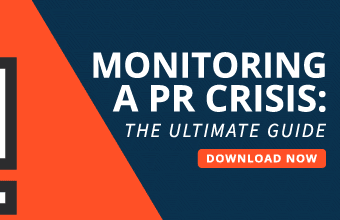In the realm of public relations, the saying “an ounce of prevention is worth a pound of cure” rings true. Indeed, proactive PR measures can prevent reputation disasters, helping businesses not only survive but also thrive in the face of potential threats. To help you safeguard your business through PR strategies, we’ve gathered seven pro tips. So let’s get to work!

Nipping problems in the bud: The power of proactive public relations
We can all agree that prevention is better than cure, especially when it concerns a company’s reputation. Just as we take care of our health to ward off illness, so should businesses consider their reputation a precious commodity requiring continuous nurturing.

Proactive PR harnesses foresight and strategic planning to shield a company’s reputation against potential threats effectively.
The PR industry has developed an array of measures designed to anticipate, prevent, and manage potential threats before they escalate into full-blown crises. Here, we delve into seven ways proactive PR measures can prevent reputation disasters.
1 Constructing a resilient brand with powerful messaging
A company’s message functions as its guiding beacon. It provides direction, illuminates the brand’s essence, and influences the perception of audiences. Therefore, crafting a potent, lucid, consistent message across all communication platforms is paramount. This involves more than just defining your mission statement. It’s about conveying your company’s ethos, vision, and values consistently – from marketing campaigns and social media posts to customer service interactions and internal communications.
When your message is strong and steady, it cements your brand identity in the consumer’s mind. The expert team from convertmore.com underlines this significance, stating, “A coherent, engaging narrative is a steadfast armor protecting your brand’s reputation by continuously bolstering positive public perception.”
2 Maintaining vigilance through constant monitoring and prompt responses
In today’s hyper-connected world, information spreads like wildfire. What starts as a spark—a single negative comment or review—can rapidly escalate into a consuming blaze, potentially causing irreversible reputation damage. Therefore, maintaining vigilance through continuous monitoring of your brand’s online presence is critical.
It’s essential to keep an ear to the ground, understanding what’s being said about your company across various channels—be it social media, blogs, review sites, or media publications. Doing so lets you detect potential threats early and address them swiftly and efficiently, preventing small issues from ballooning into public relations nightmares.
3 Cultivating trust through transparency and accountability
Openness and responsibility are the pillars of trust and respect in public relations. Upholding transparency means being forthcoming about your company’s operations, policies, and actions. It involves sharing the good and not shying away from the not-so-good.
On the other hand, demonstrating accountability involves acknowledging mistakes when they occur, taking responsibility, and outlining concrete steps to rectify the situation. When companies embrace transparency and accountability, they not only mitigate potential damage during crises but can often enhance public perception, turning potential reputation disasters into opportunities for reputation enhancement.
4 Strategizing for the unexpected with a crisis management plan
The adage ‘hope for the best, prepare for the worst’ holds significant relevance in reputation management. Creating a comprehensive crisis management plan is a crucial proactive PR measure. This plan should be an exhaustive guidebook detailing how to respond to various potential crises.

Having a crisis management plan in place is a testament to how proactive PR measures can prevent reputation disasters.
It should designate who the spokespersons are, what communication channels to use, and how to tailor messages for different audiences. Having such a plan in place is akin to having a road map during a storm—it provides guidance, facilitates rapid decision-making, and ensures a coordinated response, thereby lessening the impact of a PR disaster.
5 Ensuring preparedness through regular training and simulations
In the face of potential crisis scenarios, the ability to react rapidly and effectively can make the difference between a reputation catastrophe and a reputation preserved. Central to this agility is the implementation of regular training and simulation exercises—a strategic PR measure designed to equip your team with the skills, knowledge, and confidence to navigate stormy waters.
These training sessions aren’t merely about rehearsing steps; they’re about developing a deep understanding of the plan’s intricacies and cultivating the ability to adapt swiftly in the heat of a real crisis. It involves role-playing scenarios, learning to handle media interactions, and understanding the essence of sensitive communication during high-pressure situations.
Simulations, on the other hand, provide a realistic, safe environment to test the plan and your team’s crisis management capabilities. They help identify potential roadblocks and weak spots in your response strategy, allowing for proactive tweaking and fortifying your plan.
Furthermore, harnessing the power of business analytics can immensely enhance these simulation exercises. You can create realistic, relevant scenarios that anticipate potential future crises by analyzing historical data on past crises and current trends. This strategic integration of business analytics into your training and simulation framework can provide rich insights and, ultimately, more effective crisis preparedness.
6 Building goodwill through community engagement
Fostering relationships with the local community and wider public is like depositing into a bank of goodwill. Regular community engagement initiatives—whether through volunteer work, sponsorships, or social responsibility programs—can create a supportive network that stands by your company during tough times.
Furthermore, active engagement helps you stay attuned to public sentiment and concerns, allowing for the early identification and proactive addressing of potential issues, thereby safeguarding your reputation.
7 Leveraging the power of influencers
Influencers have emerged as trusted voices within their communities. Their opinions can significantly shape public perception. Therefore, partnering with influencers whose values align with your brand can offer an extra layer of protection for your reputation. It’s one of the best ways to use social media to grow your business.

Leveraging influencers in your PR strategy is akin to enlisting allies, as they provide valuable endorsements and extend your reach.
Influencer endorsements can serve as powerful testimonials during challenging times, helping to reassure audiences and mitigate potential reputation damage. Collaborations can take various forms, from product reviews and sponsored content to event appearances, providing opportunities to enhance your brand’s visibility, credibility, and resilience.
Safeguarding your image: The final word
In the world of PR, anticipation, readiness, and rapid response are the pillars that uphold a company’s reputation. Through the strategic implementation of these seven ways, proactive PR measures can prevent reputation disasters, securing your brand’s bright and resilient future.







